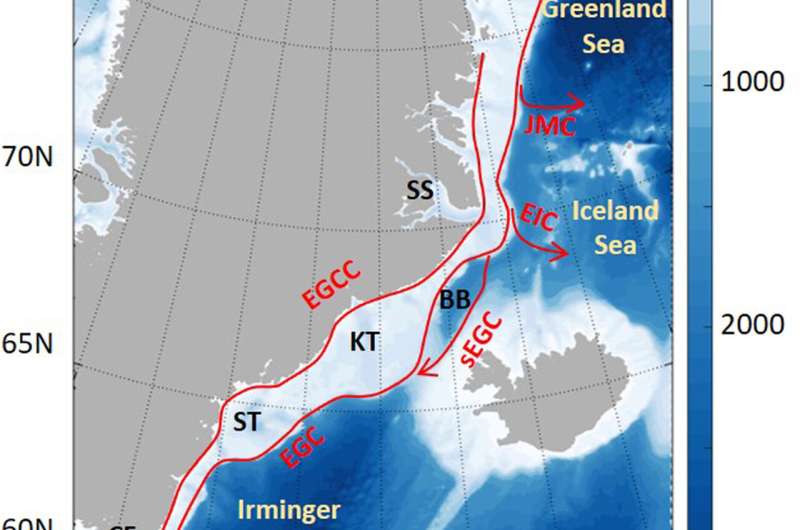This article has been reviewed according to Science X's editorial process and policies. Editors have highlighted the following attributes while ensuring the content's credibility:
fact-checked
peer-reviewed publication
trusted source
proofread
Light freshwater sticks to Greenland's east coast, finds researcher

Meltwater that runs along the east coast of Greenland, hardly enters the open ocean before reaching the western side of the island. That is one of the conclusions NIOZ Ph.D.-candidate Elodie Duyck draws in the thesis that she defended on Oct. 23 at Utrecht University. In the changing climate, fresh water from Greenland and the Arctic could disrupt the circulation in the Atlantic Ocean. "Understanding where, and how much, of that fresh and light water enters the Atlantic Ocean is critical to predict how the circulation may evolve under climate change," Duyck says.
In the coming decades, climate change will lead to increasing amounts of freshwater from Greenland and the Arctic entering the northern North Atlantic Ocean. These waters are less dense than the seawater around Greenland and may hinder the exchange between the surface and deep ocean that usually takes place in this region.
This could lead to a weakening of the so-called Atlantic Meridional Overtuning Circulation (AMOC), the large-scale circulation of the Atlantic Ocean, that brings warm water northward at the surface and returns cold water southward at greater depths, affecting the climate in large parts of the world.
Waters from Greenland and the Arctic initially flow close to the Greenland coast. The extent to which the fresh water then spreads into the open ocean remains uncertain. Direct measurements of the circulation, done by NIOZ and others in the scientific program "Overturning in the Subpolar North Atlantic Program' (OSNAP), show that the Irminger Sea, south-east of Greenland, is particularly important for the Atlantic Ocean's circulation.
To investigate whether fresh waters enter the Irminger Sea, Duyck deployed a total of 120 buoys along Greenland's east coast. Using sea anchors, she ensured that those buoys drifted with the surface currents, free from the disruptive influence of wind or waves. Those buoys were carried southward along the Greenland coast, until they reached the western side of Greenland.
Duyck identified a few areas along the eastern coast of Greenland where fresh shelf water mixes with Atlantic waters, and one area, at the southernmost tip of Greenland, where freshwater may be exported in larger quantities during strong wind events. But overall, buoys tended to remain close to the coast until they reached the western side of Greenland. "This means that meltwater hardly flows from the south-east coast of Greenland to the Irminger Sea," Duyck explains.
About one third of the buoys that were released on the eastern side of Greenland were exported to the Labrador Sea, on the western side of Greenland, where more exchange between the coastal area and the open ocean is known to take place.
"This means that the circulation on the eastern side of Greenland may impact how much freshwater enters the Labrador Sea, on the western side of Greenland," Duyck says. The fresh doctor is already working on a new project, at the University of Hamburg, where she uses similar instrument to investigate how freshwater enters the Labrador Sea and how this may affect the ocean circulation in the future.
The findings are published in the Journal of Geophysical Research: Oceans.
More information: E. Duyck et al, Cross‐Shelf Exchanges Between the East Greenland Shelf and Interior Seas, Journal of Geophysical Research: Oceans (2023). DOI: 10.1029/2023JC019905
Journal information: Journal of Geophysical Research
Provided by Royal Netherlands Institute for Sea Research




















